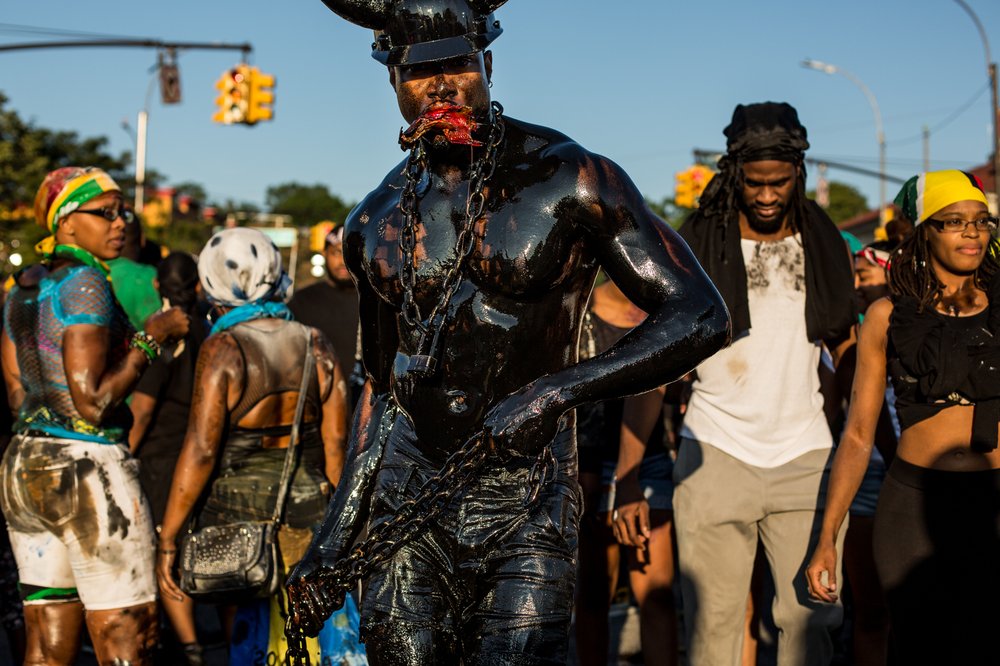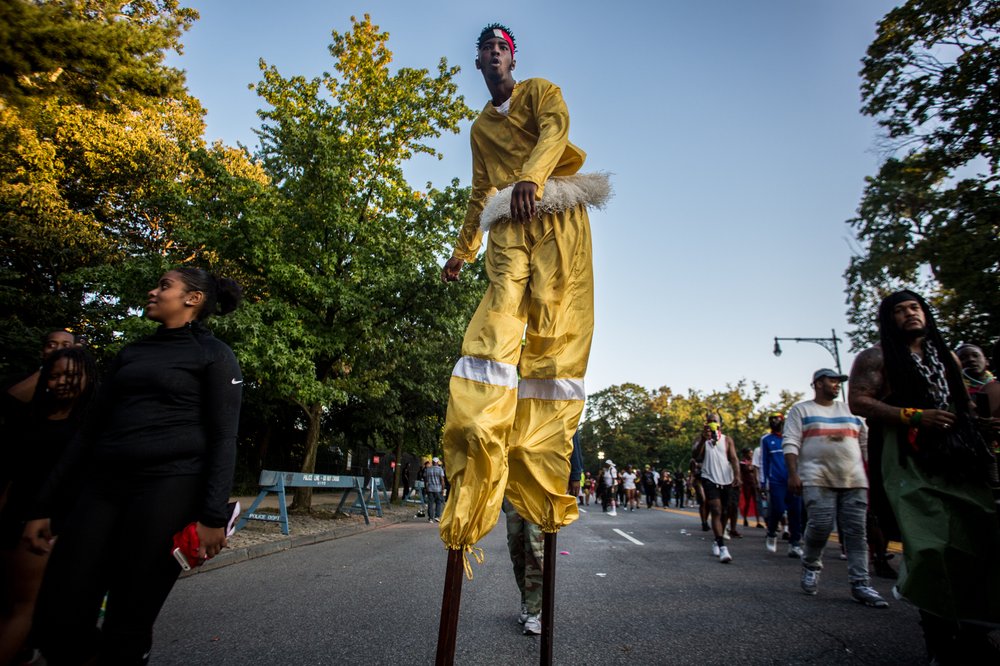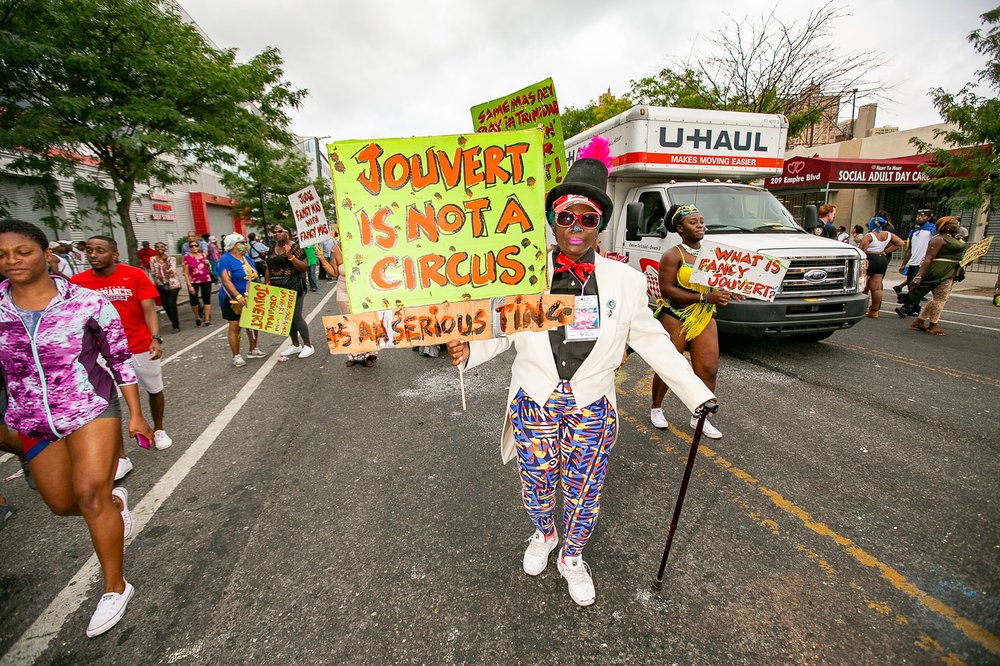Vibrant J'Ouvert festivities return to Brooklyn, with characters from Jab Molassie to Baby Doll
Sept. 4, 2022, 10 a.m.
As J’Ouvert returns to the streets of Brooklyn, people will once again dress in outlandish clothing to represent folkloric characters.
Early in the morning on Labor Day, the melodic sounds of steel-pan drumming and the roar of cheering crowds will awaken many New Yorkers as the Caribbean celebration J’Ouvert rolls through Brooklyn streets. J’Ouvert, French for “break of day,” marks the beginning of the West Indian Day Parade and Carnival. It hasn't happened on an official level in New York City since 2019 because of the coronavirus pandemic. But it’s back in full force this year, including a pageant-like procession of costumed celebrants whose flamboyant attire represents elements of history and folklore.
“A lot of people don’t understand J’Ouvert,” Sandra Bell, a third-generation Carnival costume maker and production stage manager, told Gothamist. Bell was born in Trinidad and has celebrated J’ouvert in Brooklyn for years. “They don't understand it came out of struggle, and the fight for our cultural expression,” she said.
J’Ouvert and Carnival are mostly known now for their vibrant showcase of Caribbean culture, but the occasion also has historical roots. One common take on its origin is that Carnival was introduced by French colonials when they arrived in Trinidad in 1783. During this time, Trinidad became a plantation economy and a slave society. Masked balls arrived as French culture permeated the island, but enslaved people weren’t allowed to attend such gatherings. In response, they hosted their own events, using their history, rituals, and folklore to entertain themselves while mocking the slave masters.
After emancipation came on Aug. 1, 1838, J’Ouvert evolved into a commemoration of newfound freedom. The pre-Carnival celebration typically starts before sunrise, around 3 or 4 a.m., and carries on until the start of the Day Parade mid-morning.
While many participants will favor attire that's barely there, others uphold a tradition of representing figures from historic folklore. Below, Bell and another expert, Brooklyn College professor Dale Byam, explain who these characters are and what they represent.

A Jab Jab player at Brooklyn J'Ouvert in 2017.
Jab Molassie
The most common character people will encounter at J’Ouvert is the Jab Jab or Jab Molassie. Both are variations of a “devil,” Bell said. “They’re very scary creatures.” Smeared in black paint, mud, or oil, Jab is most recognizable because of the long plastic horns that adorn its head. The character, she said, represents the evils of the slave masters.
“They would be dancing on the street with European clothing on and so in essence the message they were sending is that the Jab Jab that they had encountered when they were a slave was a slave owner,” said Byam, an assistant professor in the Africana Studies department at Brooklyn College.
“You can go from island to island and see the Jab in various forms,” she explained. “You can see them sometimes blackened in European clothing, or you could see them blackened with chains around their neck and horns.” In addition to whips and chains, people portraying Jab might carry pitchforks, and can be painted in blue, red, or green instead of black.

A Moko Jumbie player at Brooklyn J'Ouvert in 2018.
Moko Jumbie
Though not as common on the streets of Brooklyn as the Jab Jab, the Moko Jumbie is just as intriguing. The character derives part of its name, practice, and meaning from West Africa, as "Moko" is a healer in the Kongo language. Once the stilt-walking tradition made its way to the Caribbean, the Trinidadian people added "Jumbie," meaning ghost or spirit.
“They are the ones who are above the rest of us,” Bell said. “They’re the protectors of the village. They see from far. They can tell you something is coming.”
Moko Jumbie’s attire is as outlandish as can be. Not only are people usually on stilts, but they also wear extremely colorful clothing and creatively decorative headwear.
“He in some cultures is a shaman or a diviner,” Byam said. “When the slaves think about Moko Jumbie, they also think of him as a kind of spirit or ghost. He was on those stilts because he could sort of look over the crowd and protect the village.”
Dame Lorraine
Bell said the Dame Lorraine character became a vehicle for criticism of the French aristocracy. Usually dressed in long ruffled dresses and gloves, and carrying a pocketbook and umbrella, the character is a “mimicking of the plantation owners' wives,” Bell said. “They also wear a wire mask with a European face painted on it. They wear hats with flowers, and they have enlarged breasts. It’s all in making fun of these European women.”
Byam agreed. “They are mimicking the idea of power and how we use power,” she said. “They would give themselves ostentatious names and parody the way the Europeans danced. These physical characteristics were comic-like, and it drew a lot of laughter.”
Baby Doll
The meaning and context of the Baby Doll has changed over time, according to Byam. The character is dressed in frilly pink, white or purple dresses and bonnets, and carries a toy baby doll on its hip. “It symbolizes a child that was born out of wedlock,” she said. “And then the Baby Doll character would approach someone, particularly a man, and accuse him of being the father.”
“It's a mimicking of a tragic story,” Bell elaborated. “They're making a caricature out of a situation that's happened a lot during those times.”
While in the beginning Baby Doll was typically portrayed by men, Byam explained, the character more recently has emerged as a gesture of activism among women. “A few students of mine had sent me photos of themselves,” she said, “and they’re feminists who are out there using this as a sort of stage to speak about specific issues facing women.”

A reveler at Brooklyn J'Ouvert in 2019.